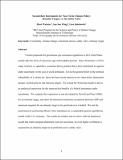| dc.contributor.author | Webster, Mort | |
| dc.contributor.author | Sue Wing, Ian | |
| dc.contributor.author | Jakobovits, Lisa | |
| dc.date.accessioned | 2015-09-17T17:14:54Z | |
| dc.date.available | 2015-09-17T17:14:54Z | |
| dc.date.issued | 2010-03 | |
| dc.date.submitted | 2007-12 | |
| dc.identifier.issn | 00950696 | |
| dc.identifier.issn | 1096-0449 | |
| dc.identifier.uri | http://hdl.handle.net/1721.1/98537 | |
| dc.description.abstract | Current proposals for greenhouse gas emissions regulations in the United States mainly take the form of emissions caps with tradable permits. Since Weitzman's (1974) [3] study of prices vs. quantities, economic theory predicts that a price instrument is superior under uncertainty in the case of stock pollutants. Given the general belief in the political infeasibility of a carbon tax in the US, there has been recent interest in two other policy instrument designs: hybrid policies and intensity targets. We extend the Weitzman model to derive an analytical expression for the expected net benefits of a hybrid instrument under uncertainty. We compare this expression to one developed by Newell and Pizer (2006) [6] for an intensity target, and show the theoretical minimum correlation between GDP and emissions required for an intensity target to be preferred over a hybrid. In general, we show that unrealistically high correlations are required for the intensity target to be preferred to a hybrid, making a hybrid a more practical instrument in practice. We test the predictions by performing Monte Carlo simulation on a computable general equilibrium model of the US economy. The results are similar, and we show with the numerical model that when marginal abatement costs are non-linear, an even higher correlation is required for an intensity target to be preferred over a safety valve. | en_US |
| dc.description.sponsorship | Doris Duke Charitable Foundation | en_US |
| dc.language.iso | en_US | |
| dc.publisher | Elsevier | en_US |
| dc.relation.isversionof | http://dx.doi.org/10.1016/j.jeem.2010.01.002 | en_US |
| dc.rights | Creative Commons Attribution-Noncommercial-NoDerivatives | en_US |
| dc.rights.uri | http://creativecommons.org/licenses/by-nc-nd/4.0/ | en_US |
| dc.source | Other univ. web domain | en_US |
| dc.title | Second-best instruments for near-term climate policy: Intensity targets vs. the safety valve | en_US |
| dc.type | Article | en_US |
| dc.identifier.citation | Webster, Mort, Ian Sue Wing, and Lisa Jakobovits. “Second-Best Instruments for Near-Term Climate Policy: Intensity Targets vs. the Safety Valve.” Journal of Environmental Economics and Management 59, no. 3 (May 2010): 250–259. | en_US |
| dc.contributor.department | Massachusetts Institute of Technology. Joint Program on the Science & Policy of Global Change | en_US |
| dc.contributor.mitauthor | Webster, Mort | en_US |
| dc.contributor.mitauthor | Jakobovits, Lisa | en_US |
| dc.relation.journal | Journal of Environmental Economics and Management | en_US |
| dc.eprint.version | Author's final manuscript | en_US |
| dc.type.uri | http://purl.org/eprint/type/JournalArticle | en_US |
| eprint.status | http://purl.org/eprint/status/PeerReviewed | en_US |
| dspace.orderedauthors | Webster, Mort; Sue Wing, Ian; Jakobovits, Lisa | en_US |
| mit.license | PUBLISHER_CC | en_US |
| mit.metadata.status | Complete | |
